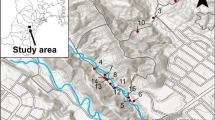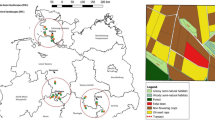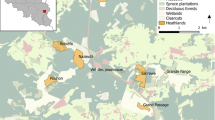Summary
In 4 common Middle-European mainly bumblebee-pollinated plant species (Impatiens glandulifera, Echium vulgare, Aconitum napellus, Symphytum officinale) the influence of patch size on species composition of the pollinator community was studied. Short-tongued species were most dominant in large patches, while small patches were frequented by middle- and long-tongued bumblebees. This phenomenon was extremely obvious in Symphytum officinale and Aconitum napellus, where short-tongued species had bitten a hole in nearly every flower of large patches. Long-tongued species were forced to small patches, where nectarrobbing occurred only exceptionally. In small patches visitationrate (Number of visits per flower per hour) was not lower but either equal or even higher then in large patches. Nectar measurements in Echium vulgare showed, that not only the mean quantity of nectar but also the variance was lower in small patches. As a result, the possible gain can be predicted much more precisely in a small patch than in a large one, and bumblebees have less difficulties in making the right foraging decisions. According to this, foraging strategies depend on patch size. This was confirmed by a computer simulation. The conclusion can be drawn, that many bumblebee species are able to share the same resource by using different patch sizes. Since large flower patches occur mainly in man-made habitats, the dominance of short-tongued species in many bumblebee communities studied by other authors may be unnatural.
Similar content being viewed by others
References
Anasiewicz A, Warakomska Z (1977) Pollen food of the bumblebees (Bombus Latr., Hymenoptera) and their association with the plant species in the Lublin region. Ekol Pol 25:309–322
Barrow DA, Pickard RS (1984) Size-related selection of food plants by bumblebees. Ecol Entomol 9:369–373
Charnov EL (1976) Optimal foraging: The marginal value theorem. Theor Popul Biol 9:129–136
Corbet S (1978) Bee visits and the nectar of Echium vulgare L. and Sinapis alba L. Ecol Entomol 3:25–37
Feinsinger P (1976) Organization of a tropical guild of nectarivorous birds. Ecol Monogr 46:257–291
Free JB (1955) The collection of food by bumblebees. Insectes Soc 2:303–311
Hanski I (1982) Communities of bumblebees: testing the core-satellite species hypothesis. Ann Zool Fenn 19:65–73
Heinrich B (1976) Resource partitioning among some eusocial insects: bumblebees. Ecology 57:874–889
Hodges CM (1981) Optimal foraging in bumblebees: Hunting by expectation. Anim Behav 29:1166–1171
Hodges CM (1985) Bumble bee foraging: energetic consequences of using a threshold departure rule. Ecology 66:188–197
Janzen DH (1971) Euglossine bees as long-distance oollinators of tropical plants. Science 171:203–205
Johnson LK, Hubell SP (1975) Contrasting foraging strategies and coexistence of two bee species on a single resource. Ecology 56:1398–1406
Kwak MM, Holthuizen YA, Pins HHT (1985) A comparison of nectar characteristics of the bumblebee-pollinated Rhinanthus minor and R. serotinus. OIKOS 44:123–126
Legendre L, Legendre P (1983) Developments in environmental modelling, vol 3. Numerical ecology. Elsevier, Amsterdam Oxford New York, 418 pp
Morse DH (1985) Milkweeds and their visitors. Sci Am 253:90–96C
Pittioni B (1942) Hummeln als Blütenbesucher. Mitt Bulg Ent Ges Sofia 12:63–126
Pyke GH (1978 a) Optimal foraging: Movement patterns of bumblebees between inflorescence. Theor Popul Biol 13:71–98
Pyke GH (1978 b) Optimal foraging in hummingbirds: Testing the marginal value theorem. Am Zool 17:739–752
Pyke GH (1980) Optimal foraging in bumblebees: Calculation of net rate of energy intake and optimal patch choice. Theor Popul Biol 17:232–246
Pyke GH (1982) Local geographic distributions of bumblebees near Crested Bute, Colorado: Competition and community structure. Ecology 63:555–573
Rathcke B (1983) Competition and facilitation among plants for pollination. In: Real L (ed) Pollination biology. Academic Press, New York, pp 305–329
Ranta E, Lundberg H (1980) Resource partitioning in bumblebees: the significance of differences in proboscis length. OIKOS 35:298–302
Rasmont P (1983) Catalogue commenté des bourdons de la région ouest-paléarctique (Hymenoptera, Apoidea, Apidae). Notes Faun Gembloux 7:1–71
Rasmont P (1984) Les bourdons du genre Bombus Latreille sensu stricto en Europe Occidentale et Centrale. Spixiana 7:135–160
Renkonen O (1938/1939): Statistisch-ökologische Untersuchungen über die terrestrische Käferwelt der finnischen Bruchmoore. Ann Zool Soc Zool Bot Fenn Vanamo 6:1–231
Sih A, Baltus MS (1987) Patch size, pollinator behavior, and pollinator limitation in catnip. Ecology 68:1679–1690
Teräs I (1985 a) Food plants and flower visits of bumblebees (Bombus: Hymenoptera, Apidae) in southern Finland. Acta Zool Fenn 179:1–120
Teräs I (1985 b) Flower visits of bumblebees (Bombus: Hymenoptera, Apidae) during one day in northeastern Finland. Notulae Entomol 65:129–135
Waddington KD, Allen I, Heinrich B (1981) Floral preferences of bumble bees (Bombus edwardsii) in relation to intermittent versus continuous rewards. Anim Behav 29:779–784
Wright DH (1985) Patch dynamics of a foraging assemblage of bees. Oecologia (Berlin) 65:558–565
Zimmerman M (1981) Patchiness in the dispersion of nectar resources: Probable causes. Oecologia (Berlin) 49:154–157
Author information
Authors and Affiliations
Additional information
Supported by the “Landesgraduiertenförderung Baden-Württemberg”
Rights and permissions
About this article
Cite this article
Sowig, P. Effects of flowering plant's patch size on species composition of pollinator communities, foraging strategies, and resource partitioning in bumblebees (Hymenoptera: Apidae). Oecologia 78, 550–558 (1989). https://doi.org/10.1007/BF00378747
Issue Date:
DOI: https://doi.org/10.1007/BF00378747




